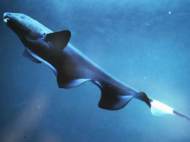Black ghost knifefish biomimicry inspired GhostBot robot
 Researchers at Northwestern University have created a robotic fish that can move from swimming forward and backward to swimming vertically almost instantaneously by using a ribbon-like fin inspired by the black ghost knifefish – a night fish that lives in rivers of the Amazon basin. It hunts for prey using a weak electric field around its entire body and moves with a ribbon-like fin on the underside of its body.
Researchers at Northwestern University have created a robotic fish that can move from swimming forward and backward to swimming vertically almost instantaneously by using a ribbon-like fin inspired by the black ghost knifefish – a night fish that lives in rivers of the Amazon basin. It hunts for prey using a weak electric field around its entire body and moves with a ribbon-like fin on the underside of its body.
Led by Malcolm MacIver, associate professor of mechanical and biomedical engineering at Northwestern’s McCormick School of Engineering and Applied Science, the team started to develop GhostBot robot. The development began when graduate student Oscar Curet observed a knifefish suddenly moving vertically in a tank in MacIver’s lab. Working with Neelesh Patankar, associate professor of mechanical engineering, he has created mechanical models of the fish in hopes of better understanding how the nervous system sends messages throughout the body to make it move.
Further observations revealed that the fish only uses one traveling wave along the fin during horizontal motion (forward or backward depending on the direction on the wave), and it uses two waves while moving vertically. One of these moves from head to tail, and the other moves tail to head. The two waves collide and stop at the center of the fin.
The team then created a computer simulation that showed that when these “inward counter-propagating waves” are generated by the fin, horizontal thrust is canceled and the fluid motion generated by the two waves is funneled into a downward jet from the center of the fin, pushing the body up. The flow structure looks like a mushroom cloud with an inverted jet.
“It’s interesting because you’re getting force coming off the animal in a completely unexpected direction that allows it to do acrobatics that, given its lifestyle of hunting and maneuvering among tree roots, makes a huge amount of sense”, said MacIver.
The group then hired Kinea Design, a design firm founded by Northwestern faculty that specializes in human interactive mechatronics, and worked closely with their co-founder, Michael Peshkin, professor of mechanical engineering, to design and build a robot. The company came up with waterproof robot with 32 motors which provide independent control of the 32 artificial fin rays of the lycra-covered artificial fin.
The group took the robot to Harvard University to test it in a flow tunnel in the lab of George V. Lauder, professor of ichthyology. They measured the flow around the robotic fish by placing reflective particles in the water, and afterwards they used a laser sheet which allowed them to track the flow of the water by watching the particles. The tests showed the water flows around the biomimetic robot just as computer simulations predicted it would.
The robot is also outfitted with an electrosensory system that works similar to the knifefish’s, and MacIver and his team hope to improve the robot so it can autonomously use its sensory signals to detect an object and then use its mechanical system to position itself near an object.
Potential applications for such a robot include underwater recovery operations, such as plugging a leaking oil pipe, or long-term monitoring of oceanic environments, such as fragile coral reefs.
While the applied work on the robot moves ahead in the lab, the group is pursuing basic science questions as well. “The robot is a tool for uncovering the extremely complicated story of how to coordinate movement in animals”, said MacIver. “By simulating and then performing the motions of the fish, we’re getting insight into the mechanical basis of the remarkable agility of a very acrobatic, non-visual fish. The next step is to take the sensory work and unite the two.”










Leave your response!